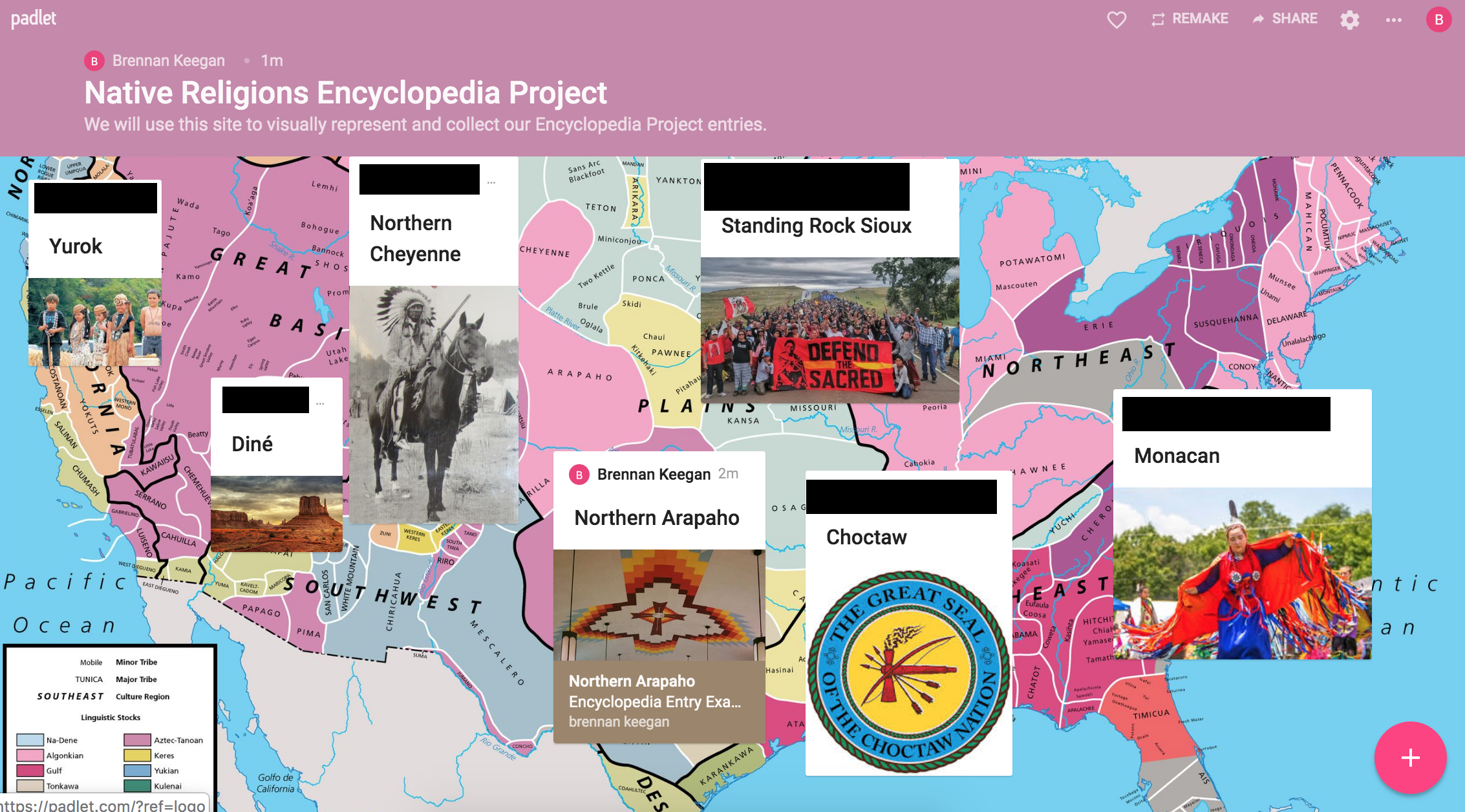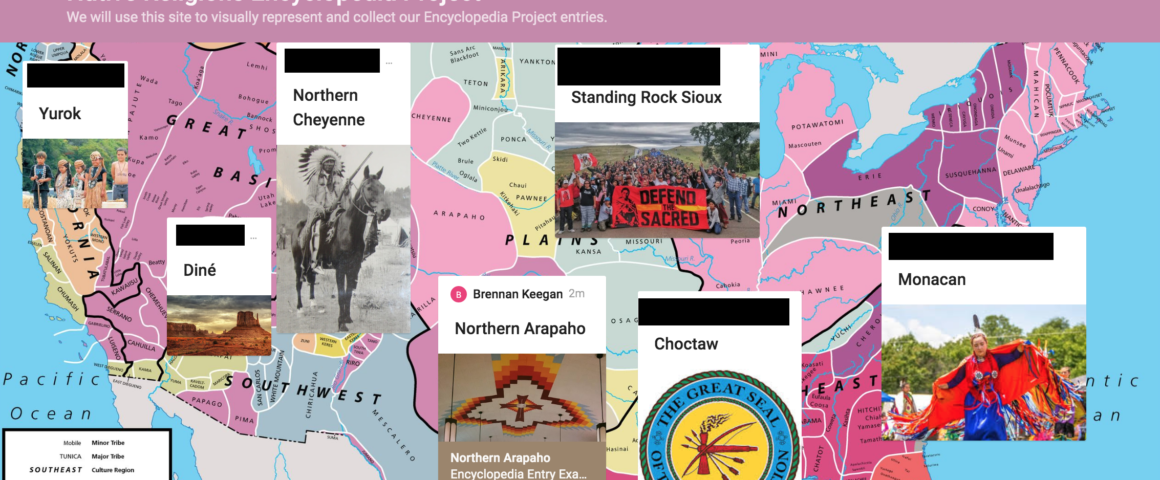For many college students, tackling original research can feel a bit like climbing the insurmountable. For a variety of reasons, ranging from teacher time constraints to increased focus on testing, many students arrive at college never having written a research paper (Wood 2010; Carter and Harper 2013). And as a report from Primary Research Group in 2018 noted, colleges are requiring fewer long-form writing assignments and students are OK with that (Whitford 2018).During fall 2018 (and again this fall), I taught Religion in Native North America, a 200-level undergraduate Religious Studies course. Taking it as a truth that research and writing remain integral skills, but recognizing my students’ concerns and probable lack of experience, I designed building block assignments throughout the semester to increase research literacy and build analytical confidence. One such assignment, was a collaborative encyclopedia entry created using the free online platform Padlet, a digital bulletin board that enables teachers and students to share images, links, videos, and text in an easily created and manipulated format.
An encyclopedia entry assignment offered students an opportunity to combine multiple sources in a single project, but remained a step away from requiring the development of an original research question or argument. I also explicitly introduced the project as a building block toward their final research papers, helping to alleviate some of the anxieties about performing research. Padlet’s easy drag and drop format enabled students to visualize and manipulate the data in ways akin to laying out flash cards. Content could be easily moved around the screen, color coded, and connected by arrows. The easy inclusion of videos and images made for richer storytelling and broadened students’ perspectives on the types of sources available for research. Students also enjoyed playing with the aesthetics of their projects, which helped students move beyond seeing each source as its own island and physically create and visualize connections. The digital format was highly accessible and easy to learn, and simply, more fun than a traditional annotated bibliography.

The Assignment
Students were asked to work in groups of two or three to research a Native American community through the lens of religion. A month before the assignment was due, we met in the library with our Research & Instruction Librarian to explore available research databases, discuss academic sources, and begin to learn how to use the digital platform. Using a minimum of five sources, they had to find information on the Tribe, including language, geographic movement, arts, history, interaction with other Tribes, Anglo settlers, missionaries, and soldiers, as well as details about religious, political, and social organization and practices. Throughout, students highlighted the connections between religious beliefs and practices and other aspects of life. For example, a creation story often directly ties the Tribe to a specific location, helps to explain social patterns and gender relations, and is represented in Tribal art and storytelling.
The Platform
In an earlier version of this course, I used Moodle’s in-house wiki platform to create a similar assignment. Ultimately, I found the wiki format was too static and students struggled with the intricacies of Wikitext. Thus, in the second iteration I turned to Padlet.
I set up the homepage or base bulletin board using the canvas feature, which enables posts to be scattered across the page. Students created their own free accounts (just an email is required) and began their entries, to which they could easily add members and link to the homepage. This format brought all of the students’ work to one space, which allowed me to check in on progress, troubleshoot issues outside of office hours, and provided students with the opportunity to see the types of things their peers had uncovered.

Content could be easily dragged and dropped into place, moved around the screen, and color coded. Students did not need to wait to add information until the end of the project, but could post and edit in real time. In addition, Padlet can be easily produced and manipulated on a smartphone. Students at my institution come from a wide range of socio-economic backgrounds and many do not own personal computers, but the vast majority do own smartphones. Programs such as Padlet, that can be accessed successfully in a variety of formats, help breach the digital divide created by access to and use of technology (Dolan 2015).

In addition to the encyclopedia entry, students were individually responsible for turning in a 250-word reflection on the research process. What was difficult or surprising about finding sources? How did you determine which sources to use? What research skills or strategies have you learned? What did you learn about your own research process and style? What do you still need to learn?
Challenges
As with all new tools, a degree of failure is expected. In two cases, students accidently deleted posts. The platform does not have a history feature or a way to retrieve deleted information, so if it’s gone, it’s gone. In addition, some students worked directly within the entry, rather than taking a middle step to analyze and gather research. This meant some of the posts on their bulletin boards were the result of a single paraphrased source, rather than achieving the greater goal of the assignment to compile information from multiple sources. As a means to help students not lose material if posts are deleted and encourage better note taking and personal analysis, in future iterations of the assignment I will recommend students keep all of their research and transcripts in Google Drive and Docs as backups.
Outcomes
On due day, students brought their devices to class and we spent the hour looking through each other’s work. Students reflected on the act of research itself, as well as the content of the entries.
For my non-Indigenous, predominately Christian students the content of this assignment helped make non-Abrahamic traditions more legible. With 573 federally recognized Tribes in the US, a focus on one community enabled students to see the more nuanced and Tribally specific frames of religious life. Significantly, Native history and religions cannot be studied without attention to settler colonialism, which has inescapably altered and harmed the communities under study (Avalos 2018). By focusing on one community, students were able to not only see the historical realities of colonialism, but the contemporary ramifications in a smaller, easier to digest case study of their own making.
As a form, the assignment gave students the opportunity to find and compile academic sources using campus databases in a lower stakes project. The collaborative bulletin board format enabled students to play with how the information was presented and helped students visualize how different sources and ideas could be connected. In addition to enjoying the project, students’ reflections noted that the following two assignments, an annotated bibliography and final research paper, felt more achievable after completing their encyclopedia entries.





'Digital Building Blocks for Original Research' has 1 comment
February 1, 2020 @ 1:35 pm Megan Heineman
[…] Digital Building Blocks for Original Research by Brennan Keegan, Randolph College […]